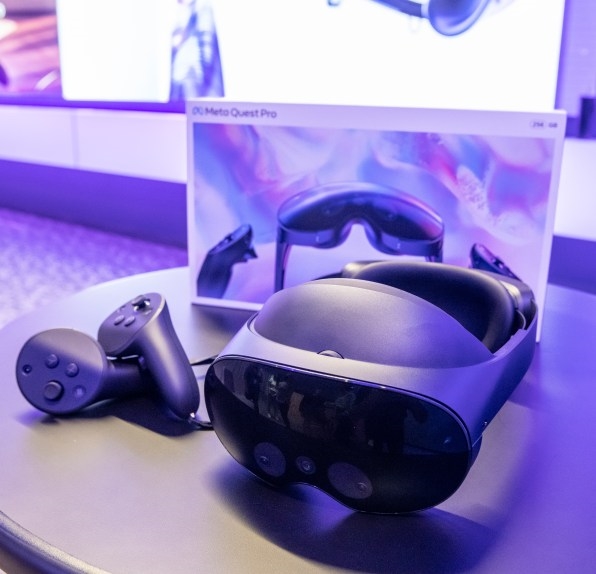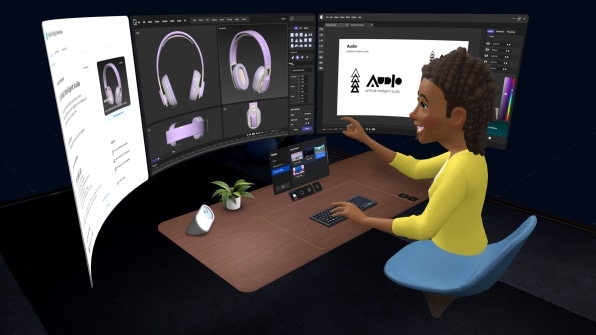Meta’s Quest Pro is no breakthrough metaverse device, but it does enable better remote work experiences
The company formerly known as Facebook announced its next-generation VR headset, the Meta Quest Pro at its Connect developer conference on Tuesday.
Meta says the device “enables the metaverse,” but the new features in Quest Pro seem focused on more practical things, namely remote work and productivity.
The Quest Pro—which is available for pre-order today, and will ship on October 25th—is also Meta’s answer to many of the shortcomings and annoyances of its earlier $399 Quest 2 headset. It’s a logical and thoughtful upgrade, but at a much higher price of $1,499. The Pro is targeted at a slightly different audience than the Quest 2. “With the Pro we are trying to take Quest beyond gaming and entertainment and into productivity, collaboration, and creativity,” a Meta spokesperson said during a product preview last week.
Eye tracking and face tracking
The Quest Pro, unlike its predecessor, has sensors inside the headset that not only track where your eyes are moving, but also your facial expressions—sort of like a more advanced version of Apple’s iPhone Memoji feature.expressions are formed.
At the product preview, one Meta engineer showed me a real-time readout within the headset of all of those places on my own face being measured and scored. There were perhaps 40 of them—some around the mouth, some around the eyes, cheeks, nose, chin, brow. The scores for each one are used to recreate my facial expressions of my avatar, which I could see in the middle of my view.
So within the collaboration experiences such as Meta’s Horizon Workrooms, co-workers can see your reactions to what’s being said. They can see when you close your eyes, and if you’re looking at them while they are speaking. This is a big step toward making VR workrooms more believable and useful.
From ‘passthrough’ to mixed reality
Wearing the Pro, you rely on a pair of cameras on the front of the device for your view of the real world around you. This “passthrough” image displayed in the lenses within the headset is a key difference between the Pro and the Quest 2. The Quest 2’s passthrough images is a grainy black and white view of the outside world that’s used mainly for safety; it lets you mark out the real-world boundaries around you so that you don’t run into an end table or a wall while you’re playing Beat Saber.
The Pro uses passthrough for far more than safety, with a real-world view that’s four times the resolution than that of the Quest 2. And, crucially, it’s now in color. This improved passthrough is the centerpiece for the Pro’s approach to mixed reality—that is, the blending of real-world objects with the digital scenes created within the headset. (Another way is making the whole front of the headset transparent, and superimposing digital imagery onto and within the real world, as in augmented reality glasses.)
The passthrough approach used by the Pro probably isn’t great for playing Pokemon Go in the park, but it might be better for attending virtual meetings in VR from your home office.
The Pro is powered by a new Qualcomm chip called the Snapdragon XR2+, which Meta says is 50% more powerful than the processor in the Quest 2. Meta has teams of engineers working on its own chip designs but it apparently chose to rely on a designer with more experience in XR processing for its new headset.

Better hand controllers
The hand controllers also get a redesign and some new features. Gone are the sensor-laden plastic ring things over your hands. The new controllers know exactly where they are in the room, enabling 360 degrees of movement with no “dead zones,” Meta says. They also add haptic feedback, so if you’re using them in, say, a music app where you’re playing some virtual drums you can feel when your drumstick hits.
The controllers also add a slot at the bottom for a stylus, so that you can hold the thing upside down and use it as a marker on a virtual white board, for example. Importantly, the controllers are way better at letting you pick up virtual stuff. For instance I found it fairly easy to pick up a virtual dart between my virtual thumb and forefinger and toss it at a virtual dartboard, a task that would have been much clunkier with the Quest 2 controllers.
About the design
The Pro uses a more open design, allowing you to see the real world in your peripheral vision while you’re in virtual space. Gone is the scuba-mask-style experience of the Quest 2, which closed out the outside world entirely. Meta made accessory pieces that you can snap onto the sides of the Pro to shut out light from the outside. Amazingly, they’re sold separately at $69.
At 720 grams the new headset is actually heavier than the Quest 2, but Meta moved the battery to the back of the headset so that the weight of the device feels more evenly distributed on your head. The new headset’s design reminds me of the design of Microsoft’s Hololens 2.
The front of the Quest Pro, interestingly, is shaped like a large pair of sunglasses. Where the Quest 2 looks like a white brick strapped to your face, the Pro’s black, reflective facade may make the device look more approachable to people who are new to VR.

The (improved) remote work experience
For the remote work demo I was asked to sit down at a desk in front of a laptop and put on the Pro headset. Within the headset I was sitting at a virtual desk with a digital representation of the laptop sitting on it. I could see a pair of smooth gray hands in front of me, the digital version of my own hands (the headset uses cameras to track your hand movements). I could see a big virtual monitor screen hanging in space directly in front of me. Hanging below that was a small control panel where I could control the functions of the headset, and dial up different apps and experiences. Horizon Workrooms was one of them.
Across the (virtual) table I saw a Meta person who I’ll call Jordan, or rather his cartoonish avatar (in virtual reality we’re going to be stuck with cartoony avatars for a while–they serve a purpose, and they can be improved.) Because of the face movement tracking, Jordan’s avatar felt more human, more expressive than the avatars I’d seen using the Quest 2. He laughed, raised his eyebrows, made a funny face. The experience was more human, and gave me more of the information I needed about Jordan to collaborate in a more lifelike way. The Spatial Audio technology helps too. I could hear his voice in the headset, and it sounded like it was coming from a place in front of me. When I turned my face away from him it sounded like his voice was coming from behind me.
He changed the environment around us a few times. We were on a patio near the ocean in Greece. Then we were in a formal looking boardroom, then a small office room. He told me that when meetings get too big it’s best to break off into smaller groups, so he showed me a large virtual room with a number of smaller tables and a podium for the meeting organizer at the front. Suddenly Jordan was sitting at one of the tables across the room, and I could faintly hear his voice talking from over there. Then he teleported me over to his table and he was sitting in front of me again.
There was also a productivity view where you can sit at your virtual desk and work. You can set up your virtual office any way you want. You can have up to three big screens in front of you. In the demo, the screen of the real-world MacBook Pro in front of me was cast onto one of the screens and I could control it using the trackpad on the laptop. I used another screen for a meeting with Jordan, and a third screen for watching a YouTube video.I probably couldn’t do these things in the real world very easily, and that they might indeed increase my productivity.
Jordan told me that because of the improved passthrough and room mapping it was now possible to set up your virtual office in a way that pulls in part of the outside world. One Meta person, he told me, put a persistent passthrough window in his virtual space so that he could see his son passing by his desk when he came home from school.
In my virtual office I got up from my chair and walked a few steps behind me to a white board. I flipped my hand controller upside down and used the stylus to write on the board. Jordan wrote me something on a virtual post-it note and stuck it up on the board. He told me these white board are persistent; that is, you can return to them days later and find them in the same place in your virtual space, and find your scribblings from last time waiting for you.
Not revolutionary, but a good step
Within the mixed reality space, the holy grail is a pair of glasses powerful enough to put high def 3D imagery in front of your eyes, yet svelte enough to be worn for long periods of the day, even in public. After all the rumors, Project Cambria, now the Quest Pro, didn’t turn out to be that. We’re still a long way from the “glasses” vision, and getting there will require breakthroughs in some pretty foundational technologies (batteries, processors, lenses, etc.). Even then it’s unclear that consumers want to wear their personal computers on their face, or that people will tolerate the risk of being observed (and possibly tracked or recorded) by such a device worn by strangers they pass on the street.
But remote work is real. And there’s a real need for better technology to better facilitate it. People in some professions in some companies are already using mixed reality technology to collaborate, and in some cases they’re saving thousands of dollars on travel expenses by eliminating in-person meetings. The improved collaboration experience enabled by Pro features such face tracking and realistic passthrough may tempt more people and companies to try collaboration in VR. For some of them the cost of a Pro headset might be covered by a single cancellation of an in-person meeting in favor of a remote one.
As for the productivity element, I would have to experience it to believe it. I like the idea of a virtual workspace that does things my physical office can’t, but I’m not sure how well I’d tolerate wearing 720 grams of weight on my head for long periods.
(51)


